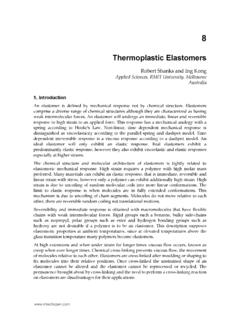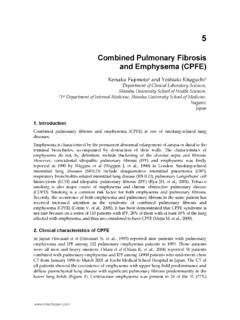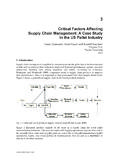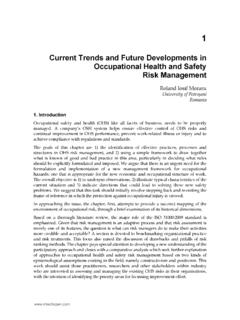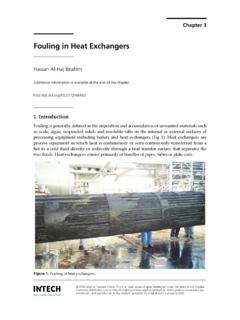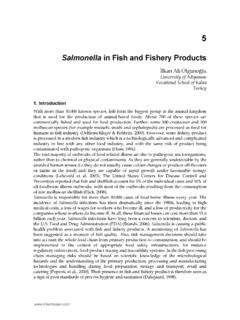Transcription of Corrosion Inhibitors Principles, Mechanisms and Applications
1 Chapter 16 Corrosion Inhibitors principles , Mechanisms andApplicationsCamila G. Dariva and Alexandre F. GalioAdditional information is available at the end of the IntroductionCorrosion processes are responsible for numerous losses mainly in the industrial scope. It isclear that the best way to combat it is the various methods to avoid or prevent destruction or degradation of metal surface,the Corrosion inhibitor is one of the best know methods of Corrosion protection and one of themost useful on the industry. This method is following stand up due to low cost and practicemethod. [1] [2] [3] [4]Important researches have being conducted with government investment mainly in large areassuch as development construction of new pipelines for shale gas and growth in focus of these researches has being the Inhibitors Applications in water and concrete forthe protection of metals.
2 [5]Historically, Inhibitors had great acceptance in the industries due to excellent anti-corrosiveproprieties. However, many showed up as a secondary effect, damage the environment. Thusthe scientific community began searching for friendly environmentally Inhibitors , like theorganic Inhibitors . [6] [7] [8] [9] [10] [11] [12] [13]This chapter presents a revision of the Corrosion Inhibitors Applications mainly the novelcompositions environmentally friendly. Is describes the Mechanisms of action of Inhibitors ,main characteristics, environmental impact, technical analysis and calculation of Mechanisms of actions of inhibitorsInhibitors are substances or mixtures that in low concentration and in aggressive environmentinhibit, prevent or minimize the Corrosion .
3 [2] 2014 Dariva and Galio; licensee InTech. This is a paper distributed under the terms of the CreativeCommons Attribution License ( ), which permits unrestricted use,distribution, and reproduction in any medium, provided the original work is properly the mechanism of the inhibitor is one or more of three that are cited below: the inhibitor is chemically adsorbed (chemisorption) on the surface of the metal and formsa protective thin film with inhibitor effect or by combination between inhibitor ions andmetallic surface; the inhibitor leads a formation of a film by oxide protection of the base metal; the inhibitor reacts with a potential corrosive component present in aqueous media and theproduct is a complex. [4] [14] [15] Historic reviewThere are many industrial systems and commercial Applications that Inhibitors are applicable,such as cooling systems, refinery units, pipelines, chemicals, oil and gas production units,boilers and water processing, paints, pigments, lubricants, etc.
4 [16]There are evidences of the use of inhibitor since the early XIX century. On that time they werealready used to protect metals in processes such as acid picking, protection against aggressivewater, acidified oil wells and cooling systems. Since years 1950's and 1960's, there wassignificant advances in the development of technology for Corrosion inhibitor as the applica tion of electrochemistry to evaluate Corrosion Inhibitors . [17]Recent studies estimate that the demand for Corrosion Inhibitors will rise per yearto USD$ billion in 2017. In 2012 they estimated that the market demand of Inhibitors wasdivided on to refining petroleum, utilities, gas and oil production, , metals, pulp and paper and other.
5 [5]Now a days, due to changes occurred on the market of Corrosion Inhibitors , some industrialcorrosion Inhibitors are being unused. Due to high toxicity of chromate, phosphate and arseniccompounds, related to various environmental and health problems, strict international lawswere imposed. Reducing the use of these and therefore increasing the need for the develop ment of other inhibitor to supply the lack in this area. Should, however, present a similar anticorrosive properties similar than a chromate inhibitor. [18]An important number of papers have been published with the intention of develop anenvironmentally friendly Corrosion Inhibitors and a lot of research has been doing to devel opment of the called green Corrosion Inhibitors .
6 [19] Also, has been increasing research innatural products, such as plant extracts, essential oils and purified compounds to obtainenvironmentally friendly Corrosion Inhibitors . [20]The first evidence of natural product use as Corrosion Inhibitors is 1930 s. When extracts ofChelidonium majus (Celadine) and other plants were used on the first time in H2SO4 picklingbaths. Successful developments of researches to obtain natural Corrosion Inhibitors aregrowing as quickly as the environmental consciousness is gaining ground.[21]Chromates as active Inhibitors are being replaced by other components such as molybdatecompounds and rare earth metal salt, like cerium chloride. Also, drugs have been studied ascorrosion Inhibitors .
7 [22] [23] [24]Developments in Corrosion Protection3662. Inhibitors classificationsThe Corrosion Inhibitors can be chemicals either synthetic or natural and could be classifiedby: the chemical nature as organic or inorganic; the mechanism of action as anodic, cathodic or a anodic-cathodic mix and by adsorptionaction, or; as oxidants or not oxidants. [4]In general, the inorganic Inhibitors have cathodic actions or anodic. The organics inhibitorshave both actions, cathodic and anodic and the protective by a film chapter is subdivided in according to the classification of the Inhibitors shown on theFigure 1 Figure 1. Classification of Inorganic Anodic inhibitorsAnodic Inhibitors (also called passivation Inhibitors ) act by a reducing anodic reaction, that is,blocks the anode reaction and supports the natural reaction of passivation metal surface, also,due to the forming a film adsorbed on the metal.
8 In general, the Inhibitors react with thecorrosion product, initially formed, resulting in a cohesive and insoluble film on the metalsurface. [4] [24]Figure 2 shows a potentiostatic polarization diagram of a solution with behavior inhibitoranodic. The anodic reaction is affected by the Corrosion Inhibitors and the Corrosion potentialCorrosion Inhibitors principles , Mechanisms and the metal is shifted to more positive values. As well, the value of the current in the curvedecreases with the presence of the Corrosion 2. Potentiostatic polarization diagram: electrochemical behavior of a metal in a solution with anodic inhibitor(a) versus without inhibitor (b).The anodic Inhibitors reacts with metallic ions Men+ produced on the anode, forming generally,insoluble hydroxides which are deposited on the metal surface as insoluble film and imper meable to metallic ion.
9 From the hydrolysis of Inhibitors results in OH- ions. [ 4] Figure 3 showshow is the mechanism of the anodic inhibitory 3. Illustration of anodic inorganic Inhibitors effect and their mechanism of the concentrations of inhibitor becomes high enough, the cathodic current density at theprimary passivation potential becomes higher than the critical anodic current density, that is,shift the potential for a noble sense, and, consequently, the metal is passivated. [25] [26]For the anodic Inhibitors effect, it is very important that the inhibitor concentrations shouldbe high enough in the solution. The inappropriate amount of the Inhibitors affects the forma Developments in Corrosion Protection368tion of film protection, because it will not cover the metal completely, leaving sites of the metalexposed, thus causing a localized Corrosion .
10 [4] [25] [26]Concentrations below to the critical value are worse than without Inhibitors at all. In generalcan cause pitting, due reduction at the anodic area relative to cathodic, or can acceleratecorrosion, like generalized Corrosion , due to full breakdown the passivity. [25]Some examples of anodic inorganic Inhibitors are nitrates, molybdates, sodium chromates,phosphates, hydroxides and Cathodic inhibitorsDuring the Corrosion process, the cathodic Corrosion Inhibitors prevent the occurrence of thecathodic reaction of the metal. These Inhibitors have metal ions able to produce a cathodicreaction due to alkalinity, thus producing insoluble compounds that precipitate selectively oncathodic sites. Deposit over the metal a compact and adherent film, restricting the diffusion ofreducible species in these areas.

